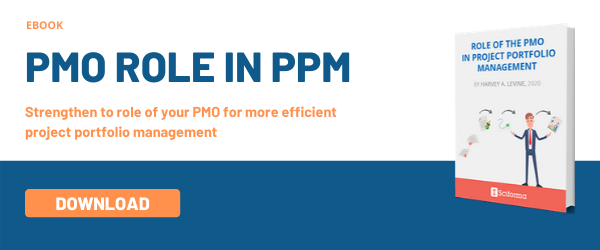Although complementary, we often associate project management and project portfolio management. However, these two theoretical frameworks do not imply the same forms of management, the same professions, or the same responsibilities. What are the main differences between those two frameworks? How to move to PPM? What is the role of the PMO? Find out the answers in our blog.
Project Management vs Project Portfolio Management
If you’ve been in the business of project management for a while, it has no secrets for you. Project management is the set of activities aimed at organizing the smooth running of a project and achieving its objectives. This is defined by a scope, a budget and a duration. To carry out this project, a set of tasks must be carried out by a collaboration of specialized resources within a defined time, under the supervision of a project manager, who ensures that they run smoothly.
The project (or program) portfolio includes all of the company’s projects. The concept of the project portfolio entails getting distance and a global vision of the projects carried out in alignment with the strategic objectives of the company. In particular, it encourages centralizing and optimizing resource allocation (especially when they are limited) and unifying information. As a result, project leaders can draw common processes within the company and improve their efficiency. In other words, portfolio management provides an overview of projects so project leaders can analyze and prioritize the ones best aligned with company strategy, while ensuring maximum efficiency.
How to Move From Project Management to Project Portfolio Management
As you will have understood, managing project portfolios brings another dimension to your business strategy. Each project stands alone, with its investments and its risks. But bringing all the projects together in a portfolio makes it possible to control and reduce the overall risk. This leads to better measurement of the profitability of each project—and of the company as a whole.
To move to PPM, it is necessary to set up tools, processes and teams within the organization. Managing a project requires technical skills linked only to the project in question. PPM requires strategy management and risk management skills.
The project portfolio management requires functions and profiles with a real interest and legitimacy to guide the selection of projects in the portfolio. Moving to PPM involves adding new methods to cover this wider field and the extended responsibilities that accompany it.
What is the Role of the PMO in PPM?
The Project Management Office (PMO) defines the standards and processes, ensures that project managers and their assistants have the required knowledge and know-how, implements tools to facilitate project management, and controls the proper use of all these resources at the portfolio level.
Sound and efficient project portfolio management happens thanks to a dedicated governance council which works in partnership with the PMO. A good PPM model combines the talents and responsibilities of the PMO and the governance council with those of senior management to ensure that projects effectively contribute to the company’s long-term ambitions and strategies.
Find out more about Project Management vs Project Portfolio Management in our eBook, “The role of the PMO in project portfolio management”








Camélia Docquin
Camélia is Sciforma’s Global Marketing Director and enjoys learning different perspectives of the current business environment and project management challenges that enterprises and individuals face daily. Main interests include : innovation, digital transformation, and strategy execution.